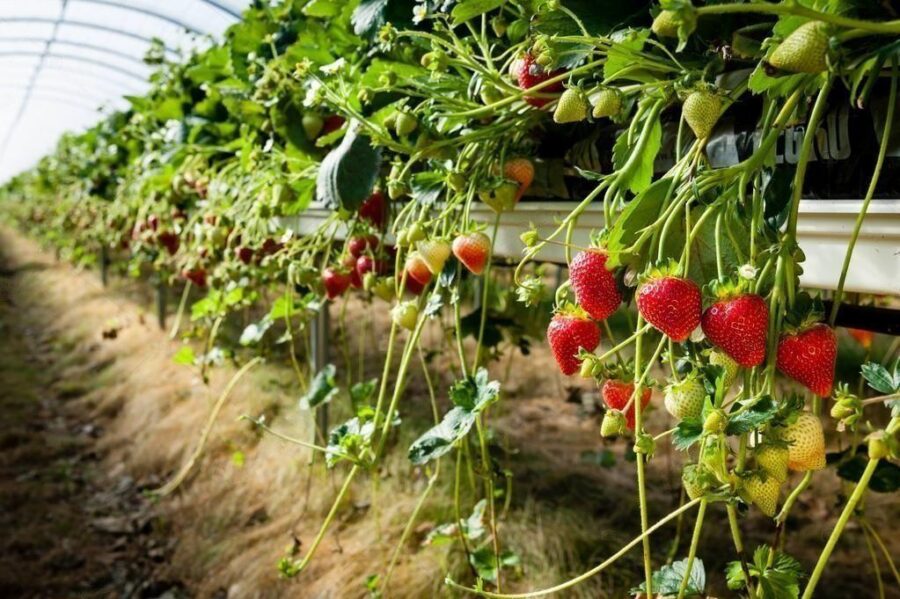Strawberry (Fragaria vesca) is a vital fruit crop in India. It has possible commercial production in temperate and subtropical regions of the country. But varieties are available that you can cultivate in the tropical climate. In India, generally, farmers cultivate strawberries in the hills. The main cultivation centres are Dehradun (Uttarakhand), Mahabaleshwar (Maharashtra), Nainital (Uttarakhand) , Kalimpong (West Bengal) and Kashmir Valley (Srinagar). In recent years, farmers have cultivated the Strawberry successfully in the plains of Maharashtra around Nashik, Sangli towns and Pune. However, strawberries are the most prevalent as a small fruit. In addition, farmers grow strawberries throughout Europe, the United States, Canada and South America. The variation in climate within the regions and the widely popular strawberry plant allows the fruit to be harvested and marketed for most of the year.
How to Start Strawberry Farming in India
Starting commercial strawberry cultivation is easy and simple, just like growing other crops. Strawberry plants are very hardy and strong, requiring less care and handling. When you start growing any plant, you need to know the essential sections that would be useful for profitable fruit cultivation. We can provide information related to the most reliable tractors in strawberry cultivation. We can recommend the Swaraj tractor, which is helpful in the complete cultivation procedure.
Suitable Climate and Soil
Farmers grow the strawberry ideal in a temperate climate. It is a short-day plant, requiring less than 8 hours of sunlight for about 10 days to flower. Exposure to low temperatures of this duration helps break the plant’s dormancy. In the spring, the days get too long, and the temperature rises. Nevertheless, plants continue to grow and flower. Varieties grown in mild subtropical climates do not require continuous growth during the winter.
From the point of view of response to light period length, strawberries are placed into two groups: (1) varieties that thrive with flower buds during long and short light periods, getting more bearing varieties. (2). On the contrary, varieties that develop flower buds affect the vise-versa of 1st condition.
Strawberries require rich, well-drained soil in organic matter. You should see slightly acidic soil with a pH of 5.7 to 6.5. Root formation is very poor at high pH (acidic). It contains high calcium in the soil and causes yellowing of the leaves. Runner formations grow best in light soils and soils rich in organic matter. You should not cultivate the strawberries in the same land for many years. It is better to plant it in a green manure field. You should not consider the alkaline soils and soils infected with nematodes for strawberry cultivation, and should avoid them.
Varieties of Strawberries
There are a massive number of varieties available. The Srinagar, Royal Sovereign and Dilpasand varieties are suitable for hilly areas. Some introductions from California, such as the Torrey, Tioga and Solana, may prove even more successful. This variety found success in Bangalore and has been named Bangalore, and has also performed well in Mahabaleshwar. For the north Indian plains, the Pusa Early Dwarf, a dwarf plant with large hard wedge-shaped fruits, is recommended. Another variety with a rich aroma but softer fruits is Catran Sweet. Some successful varieties in warmer parts of the United States are Premier Florida-90, Blackmore, Missionary, Clonmore, and Klondike.
Propagation of Strawberry Plants
You do the propagation through runners that form after the blooming duration. Plants may set as many runners as possible, but no fruit set is permitted. All plants with a good root system should be used for new planting. Given the best care and attention, a single plant typically produces 12 to 18 runners.
Best Planting Season
The ideal time for planting runners in mountainous areas is September-October. If planting is done too early, the plants lack vigour and produce low yield and fruit quality. On the other hand, if you plant it too late, runners develop in March, and crops are light.
The runners are pulled out of the nursery, bundled, and planted in the field. You can keep these in cold storage before transplanting. Apart from this, you should frequently irrigate to reduce leaf water loss. Falling stunts plant growth, delays fruiting, and reduces yield and quality.
Planting of Strawberries
- You should plant the Strawberry through deep ploughing. You should prepare it with deep ploughing and subsequently harrowing. You should incorporate liberal quantities of organic manure in the soil before planting. You can plant the strawberries on flatbeds, matted rows or in the form of hill rows, or you can plant them on raised beds.
- In irrigated areas, it is advisable to plant saplings on bunds. In Mahabaleshwar, it is common practice to plant on raised beds of 4 x 3 m or 4 x 4 m.
- In strawberry cultivation, planting distance varies according to the variety and type of land. 30 cm distance. x 60 cm. is usually followed. In the model scheme, a distance of 30 cm. x 30 cm. Considered a population of 22,000 plants per acre, typically observed in the areas covered during a field study.
- In hilly areas transplanting is done in March-April, September-October, but in plains, the months of January-February can be used for this purpose. Farmers usually plant the Strawberry November-December in Mahabaleshwar and Tamil Nadu.
- You should establish the strawberry plants in the soil, with their roots straightening. You should firmly pack the soil around the plant to keep air out. The growth point of the plant should be just above the soil surface. You should allow the plants to dry out and do the irrigation immediately after planting.
Horticultural Practices
In winter, you should cover the soil with mulch to protect the roots from freezing in the cool climate. Mulch keeps fruits free of soil, reduces fruit decay, retains soil moisture, lowers soil temperature in hot climates, protects flowers from frost in mild climates. Several types of mulch are used, but the most common is straw mulch. The name Strawberry is derived from this fact. Black alkathene mulch is also used to cover the soil. It saves irrigation water, prevents weed growth and maintains high soil temperature.
Irrigation Requirement
Strawberry, a shallow-rooted plant, requires more frequent but less water at each irrigation. Excessive irrigation leads to increased growth of leaves and stolons at the expense of fruits and flowers. Since the Strawberry is relatively shallow-rooted, it is susceptible to drought conditions. Planting early in autumn allows plants to have good vegetative growth before winter.
However, in this case, it is essential to ensure that the newly planted runners are irrigated frequently after planting. Otherwise, the death rate of the plants becomes high. You should do the Irrigation twice a week during September and October when there is no rain. You can reduce it to weekly intervals during November. However, you do the irrigation once every fortnight in December and January. When fruiting begins, the frequency of irrigation can be increased again. Repeated irrigation at this stage gives big fruits.
Pests and Diseases of Strawberries
Red spider mites and cutworms are core pests of strawberries. You can control the mites with 0.05% monocrotophos + 0.25% wettable sulphur. Before planting, the cutworms should be controlled by dusting the soil with 5% Chlordan or Heptachlor dust @ of 50 kg per hectare and mixing it well with the cultivator. The two most common diseases of strawberries are red stele, caused by the fungus Phytophthora and black root rot. The solution for the former is to grow resistant varieties such as Stellamaster and for the latter to maintain plant vigour and to rotate strawberries with other crops such as legumes (beans, peas, etc.).
Along with the process of strawberry farming, you should also consider the equipment that will help to improve the yield. Cultivators, tillers and tractors are crucial factors in strawberry farming. You can choose the Eicher tractor brand for farming in India. However, these tractor models are prevalent among farmers. Moreover, you can get the Eicher tractor price and other information online.
For further information about strawberry farming in India, stay tuned with us.


